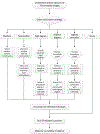Efficient vaccination strategies for epidemic control using network information
- PMID: 30878314
- PMCID: PMC6677279
- DOI: 10.1016/j.epidem.2019.03.002
Efficient vaccination strategies for epidemic control using network information
Abstract
Background: Network-based interventions against epidemic spread are most powerful when the full network structure is known. However, in practice, resource constraints require decisions to be made based on partial network information. We investigated how the accuracy of network data available at individual and village levels affected network-based vaccination effectiveness.
Methods: We simulated a Susceptible-Infected-Recovered process on static empirical social networks from 75 rural Indian villages. First, we used regression analysis to predict the percentage of individuals ever infected (cumulative incidence) based on village-level network properties for simulated datasets from 10 representative villages. Second, we simulated vaccinating 10% of each of the 75 empirical village networks at baseline, selecting vaccinees through one of five network-based approaches: random individuals (Random); random contacts of random individuals (Nomination); random high-degree individuals (High Degree); highest degree individuals (Highest Degree); or most central individuals (Central). The first three approaches require only sample data; the latter two require full network data. We also simulated imposing a limit on how many contacts an individual can nominate (Fixed Choice Design, FCD), which reduces the data collection burden but generates only partially observed networks.
Results: In regression analysis, we found mean and standard deviation of the degree distribution to strongly predict cumulative incidence. In simulations, the Nomination method reduced cumulative incidence by one-sixth compared to Random vaccination; full network methods reduced infection by two-thirds. The High Degree approach had intermediate effectiveness. Somewhat surprisingly, FCD truncating individuals' degrees at three was as effective as using complete networks.
Conclusions: Using even partial network information to prioritize vaccines at either the village or individual level, i.e. determine the optimal order of communities or individuals within each village, substantially improved epidemic outcomes. Such approaches may be feasible and effective in outbreak settings, and full ascertainment of network structure may not be required.
Keywords: Agent-based models; Sociocentric networks; Vaccination.
Copyright © 2019 The Authors. Published by Elsevier B.V. All rights reserved.
Figures




Similar articles
-
Evaluation of vaccination strategies for SIR epidemics on random networks incorporating household structure.J Math Biol. 2018 Jan;76(1-2):483-530. doi: 10.1007/s00285-017-1139-0. Epub 2017 Jun 20. J Math Biol. 2018. PMID: 28634747 Free PMC article.
-
Impact of degree truncation on the spread of a contagious process on networks.Netw Sci (Camb Univ Press). 2018 Mar;6(1):34-53. doi: 10.1017/nws.2017.30. Epub 2017 Oct 30. Netw Sci (Camb Univ Press). 2018. PMID: 29686868 Free PMC article.
-
Vaccination strategies to control Ebola epidemics in the context of variable household inaccessibility levels.PLoS Negl Trop Dis. 2019 Nov 21;13(11):e0007814. doi: 10.1371/journal.pntd.0007814. eCollection 2019 Nov. PLoS Negl Trop Dis. 2019. PMID: 31751337 Free PMC article.
-
Immunization strategies in directed networks.Math Biosci Eng. 2020 May 28;17(4):3925-3952. doi: 10.3934/mbe.2020218. Math Biosci Eng. 2020. PMID: 32987561
-
Local immunization program for susceptible-infected-recovered network epidemic model.Chaos. 2016 Feb;26(2):023108. doi: 10.1063/1.4941670. Chaos. 2016. PMID: 26931589 Free PMC article.
Cited by
-
Network Analysis of Swine Shipments in China: The First Step to Inform Disease Surveillance and Risk Mitigation Strategies.Front Vet Sci. 2020 Apr 28;7:189. doi: 10.3389/fvets.2020.00189. eCollection 2020. Front Vet Sci. 2020. PMID: 32411733 Free PMC article.
-
Protocol: Mapping social networks, social influence and sexual health among youth in rural KwaZulu-Natal, the Sixhumene cohort study.Wellcome Open Res. 2022 May 26;7:164. doi: 10.12688/wellcomeopenres.17896.1. eCollection 2022. Wellcome Open Res. 2022. PMID: 36324699 Free PMC article.
-
Using Social Networks to Understand and Overcome Implementation Barriers in the Global HIV Response.J Acquir Immune Defic Syndr. 2019 Dec;82 Suppl 3(Suppl 3):S244-S252. doi: 10.1097/QAI.0000000000002203. J Acquir Immune Defic Syndr. 2019. PMID: 31764260 Free PMC article. Review.
-
COVID-19 Vaccination in Developing Nations: Challenges and Opportunities for Innovation.Infect Dis Rep. 2021 May 14;13(2):429-436. doi: 10.3390/idr13020041. Infect Dis Rep. 2021. PMID: 34069242 Free PMC article. Review.
-
Immunization strategies in networks with missing data.PLoS Comput Biol. 2020 Jul 9;16(7):e1007897. doi: 10.1371/journal.pcbi.1007897. eCollection 2020 Jul. PLoS Comput Biol. 2020. PMID: 32645081 Free PMC article.
References
-
- Banerjee A, Chandrasekhar AG, Duflo E, Jackson MO, 2013b. The diffusion of microfinance. Abdul Latif Jameel Poverty Action Lab, v9 ed Available at: http://hdl.handle.net/1902.½1538. - PubMed
Publication types
MeSH terms
Grants and funding
LinkOut - more resources
Full Text Sources
Other Literature Sources
Medical

